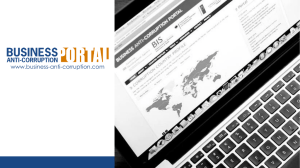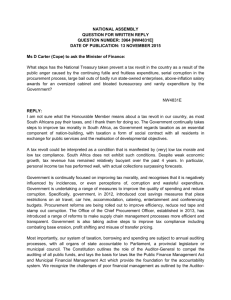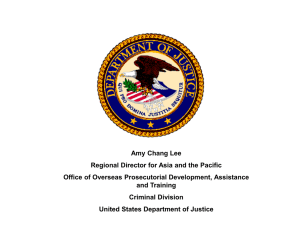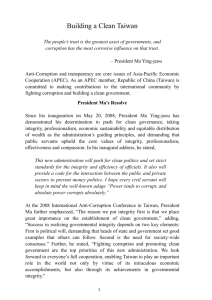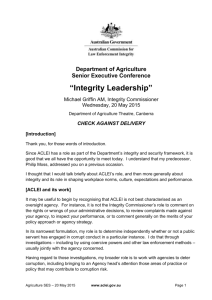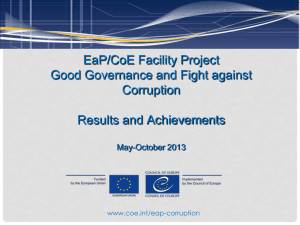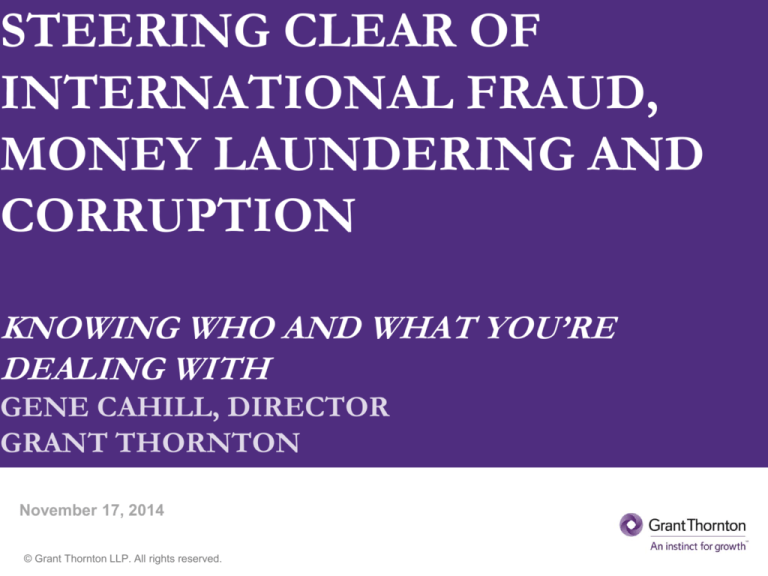
STEERING CLEAR OF
INTERNATIONAL FRAUD,
MONEY LAUNDERING AND
CORRUPTION
KNOWING WHO AND WHAT YOU’RE
DEALING WITH
GENE CAHILL, DIRECTOR
GRANT THORNTON
November 17, 2014
© Grant Thornton LLP. All rights reserved.
LEARNING
OBJECTIVES
• Introduction to Anti-Corruption and AntiMoney Laundering
• Financial Statement Ratio and Related Fraud
Risks
• Evaluating Fraud in the Manufacturing Industry
• Q&A
2
INTRODUCTION
TO
ANTI-CORRUPTION
AND
ANTI-MONEY
LAUNDERING
FCPA PROVISIONS
AND APPLICABILITY
• Anti-Bribery Provisions
o
Prohibits U.S. companies and citizens, foreign companies listed on
a U.S. stock exchange, or any persons acting while in the U.S. from
paying or offering to pay, directly or indirectly, money or anything
of value to a foreign official to obtain or retain business
• Books and Records and Internal Controls Provisions
o
Requires "issuers" (any company including foreign companies) with
securities traded on a U.S. exchange, or otherwise required to file
periodic reports with the Securities and Exchange Commission
(SEC) to keep books and records that accurately reflect business
transactions and to maintain effective internal controls.
4
REACH OF
THE FCPA
• The source of the alleged bribe does not have to be in
the U.S.
o
o
The actions of an agent, consultant and distributors acting "on
behalf" of the company will be attributed to the company.
The actions of the foreign subsidiary will be attributed to the U.S.
parent
• FCPA is jointly enforced by SEC and Department of
Justice (DOJ)
o
o
SEC generally enforces record-keeping and accounting provisions
while the DOJ enforces anti-bribery provisions.
The SEC and DOJ may conduct joint or parallel investigations.
5
CORRUPTION
RED FLAGS
The U.S. DOJ and SEC have identified corruption “red flag” scenarios which serve as a guide
for companies engaged in international business with foreign agents, partners, and joint
ventures. These include but are not limited to:
• Off-the-book accounts whereby a payment is made to an individual who then diverts
part of the proceeds to a separate account for unexplainable reasons
• An unusually large credit line for a new customer, unusually large bonus or similar
payment, or substantial and unorthodox upfront payment is requested
• A vendor has family or business ties with local government officials; or has a bad
reputation in the business community
• A potential government customer or authorizing agency recommends a vendor
• Payments to charitable organizations affiliated with foreign government officials
• Gifts, hospitality and entertainment of foreign government officials or relatives
Source: AICPA's Dealing with International JV Partners: FCPA Issues
6
CORRUPTION
ON THE MAP
• According to the Transparency International 2013
Corruption Perception Index (CPI):
7
COUNTRY SPECIFIC
CORRUPTION
•
•
•
•
Brazil
Russia
India
China
8
CORRUPTION IN
BRAZIL
Risk of Corruption
•
•
Wide range of regulatory agencies due to
the federal structure of the political
system; may increase the likelihood of
demands for bribes by public officials.
The Brazilian tax system is complex and
reportedly prone to corruption.
2013 CPI
Score: 42
Typical Schemes/Crimes
• Tax evasions by high-ranking officials,
politicians and other powerful individuals.
Business Corruption
•
•
Tax regulations can be extremely
burdensome and complicated.
Tax collectors frequently ask for bribes
to relax assessments and inspections, to
cease threatening the company, to refrain
from pursuing acts of tax fraud and to
give advice on the legal possibilities of
reducing tax obligations.
Whistle Blowing
• Public officers and private employees who
report corruption are not legally protected.
Anti-Corruption Agency
• Controladoria Geral da União (Office of the
Inspector General)
9
BRAZIL
SCENARIO
• U.S. expatriate is assigned to the São Paulo
subsidiary to integrate headquarters accounting
system.
o
o
The expatriate is required to assist with resolving
tax discrepancies with multiple Brazilian tax
authorities
The expatriate works with the local law firm to
understand the differences and broker a settlement
with the tax authority
10
CORRUPTION IN
RUSSIA
Whistle Blowing
Risk of Corruption
•
Large companies cite corruption as a
major obstacle to doing business –
inconsistent application of
laws/regulations on a non-transparent
basis, weak enforcement of laws.
• Measures are 'very weak.' No laws exists for
protection of whistleblowers.
Anti-Corruption Agency
• No specific anticorruption agency able to
investigation and prosecute corruption
Business Corruption
•
Tax regulations are identified as among
the most problematic factors for doing
business; not enforced uniformly and
without discrimination; arbitrary
environment.
Typical Schemes/Crimes
•
Widespread tax evasion
2013 CPI
Score: 28
11
RUSSIA
SCENARIO
• After the U.S. company purchases a strategic
partner located in St. Petersburg, U.S. expatriate
relocates to Russia
o
o
The expatriate learns that in order for shipments to
leave Russia, custom agents request cash payments
to be made after-hours
The expatriate learns that Russian in-house counsel
is very close to the local judge who has been
providing favorable judgments to the company
12
CORRUPTION IN
INDIA
Risk of Corruption
•
Bodies charged with combating
corruption have conflicting mandates
and lack of qualified staff and funding.
Business Corruption
•
2013 CPI
Score: 36
•
• Corporate integrity is very low
• Scandals increasingly involve high level
officials
• Federal structure of government means the
level of corruption and responses to it vary a
lot from state to state.
13
Companies report that inspection visits
are often arbitrary and excessive, at
times serving as avenues for demanding
bribes.
Majority of companies surveyed report
that in order to avoid disruptions, they
give gifts in meetings with tax
inspectors.
Anti-Corruption Agency
• Institutions at federal and state level with
authority to deal with allegations of
corruption.
INDIA
SCENARIO
• U.S. expatriate relocates to New Dehli for 18
months to perform quality control for the
manufacturing plant
o
o
The expatriate is involved with the expansion of the
plant; however, the company is required to make
cash payments to code enforcement agencies and
building inspectors in order to obtain permits and
pass building inspections.
The expatriate pays "extra" to keep electricity
running
14
CORRUPTION IN
CHINA
Risk of Corruption
•
•
Companies have difficulties with
authorities because of corrupt
behavior by their
agents/intermediaries; important to
thoroughly vet agents.
Restrictions to the freedom of speech
and press deprive China of an
effective long-term instruments in the
fight against corruption.
Business Corruption
•
Tax laws are not always enforced
uniformly or without discrimination
Typical Schemes/Crimes
•
Well-connected businessmen are able to
evade taxes
Whistle Blowing
• Article 41 of the Chinese Constitution ensures
whistleblower protection.
Anti-Corruption Agency
2013 CPI
Score: 40
• China does not have any independent anticorruption agencies; the Central Committee
of Discipline Inspection (CCDI) of the CCP
is responsible for combating corruption and
ensuring integrity amount CCP cadres.
15
CHINA
SCENARIO
• U.S expatriate relocates to Guangzhou to train
employees at the subsidiary in China on the U.S. "go to
market" strategies
o
o
The expatriate is involved with multiple business
development dinners and entertainment events with stateowned entities officials, company wins major projects as a
result of wining and dining.
The expatriate pays for vacations for prospective buyers and
their families
16
RISKS FOR ALL
COUNTRIES
• Cash transactions (including petty cash)
• Government contracts at all levels of government
• Necessary contact with government agents and foreign
regulators during the normal course of business
• Third-party contracts that are vague or lack details
• Extravagant entertainment expenses including meals,
tickets to events and travel
• Gifts outside of the normal course of business an
customs
• Operations in countries with complex and varying tax
regulations
17
ANTI-MONEY
LAUNDERING
What is Money Laundering? "The conversion or transfer of property, knowing it is derived from a
criminal offense, for the purpose of concealing or disguising its illicit origin or of assisting any person who
is involved in the commission of the crime to evade the legal consequences of his actions" United Nations
20000 Convention Against Transnational Organized Crime
What is Money Laundering used for?
1. Money must be laundered to disguise its true origin.
2. Proceeds are from illegal and criminal activities:
- Illegal arms sales
- Drug trafficking
- Smuggling
Why Money Laundering?
1. Makes illegitimate money appear legally earned
2. Attempts to hide beneficial owners
3. Attempts to avoid reporting requirements:
- Currency Transaction Reports (CTRs)
- Suspicious Activity Reports (SARs)
- Monetary Instrument Exchange Logs (MIELs)
18
TARGETED FOCUS:
MONEY LAUNDERING
A TYPICAL MONEY LAUNDERING SCHEME
Grant Thornton LLP | 32
19
MONEY LAUNDERING
EXAMPLES AND
RED FLAGS
• China - Electronics
• Brazil - Commodities
• India - Manufactured Goods
20
FINANCIAL
STATEMENT
REVIEW
KEY
RATIOS
•
Compare year-to-year
performance to determine
company’s financial status
•
Compare companies in an
industry to see which is
performing best given common
constraints
•
Benchmarks
– History
– Competition
– Industry
22
5 Groups of Key Ratios
1. Liquidity ratios
2. Efficiency ratios
3. Solvency ratios
4. Profitability ratios
5. Cash flow ratios
CURRENT RATIO
Current Assets
Current Liabilities
Interpretation: The ability of the business to meet its current obligations, while maintaining a margin of
safety to allow for possible shrinkage in the value in its various current assets such as inventories and
receivables.
Current Ratio
2013
2014
2.813 x
1.197 x
QUICK RATIO
Current Assets - Inventory
Current Liabilities
Interpretation: Inventories are typically the least liquid of a company’s current assets, hence they are the
assets on which losses are most likely to occur in the event of a liquidation. The quick ratio is a
measurement of the firm’s ability to pay off short-term obligations without relying on the sale of
inventories.
2013
Quick Ratio
1.2668 x
2014
23
.8931 x
INVENTORY
TURNOVER RATIO
Cost of Goods Sold
Average Inventory
Interpretation: The inventory turnover ratio measures the number
of times the inventory is turned over in a year. This ratio is
important, as profit is generated when inventory is sold.
2013
3.208 x
Inventory Turnover Ratio
24
2014
2.913 x
Analysis ofSALES
Financial Statements
DAYS
Days Sales Outstanding
OUTSTANDING
Receivables
Sales/365
Interpretation: Days sales outstanding is also commonly referred to
as the “average collection period”. This ratio represents the average
length of time that a company must wait to receive payment on its
sales.
Days Sales Outstanding
2013
43.94 x
25
2014
53.25 x
TOTAL ASSETS
TURNOVER
Sales
Total assets
Interpretation: The total assets turnover ratio measures the turnover
of all the company’s assets.
Total Assets Turnover
2013
1.67 x
26
2014
1.44 x
DEBT TO EQUITY %
Total Liabilities
Stockholders’ Equity
Interpretation: This ratio provides some insight into the relative size
of the “cushion” of ownership funds that creditors can rely upon to
absorb possible losses from operations. The debt to equity ratio is
frequently referred to as the leverage ratio, since it shows the relative
use of borrowed funds as compared to resources invested by owners.
Debt to Equity %
2013
390.83%
27
2014
610.14%
Analysis of Financial Statements
INTEREST
COVERAGE
Interest Coverage
EBIT
Interest Expense
Interpretation: This ratio measures the ability of a company to meet
its annual interest payments. An alternate interpretation may be that
the ratio measures the extent to which operating income can decline
before the company is unable to meet its annual interests costs.
Interest Coverage
2013
-1.26 x
28
2014
.41 x
GROSS PROFIT %
Sales – Cost of Goods Sold
Sales
Interpretation: This key ratio measures the profit margin achieved
from selling the company’s products. The gross profit percentage
assists in understanding the company’s pricing structure, overhead
structure and its ultimate profit level.
Gross Profit%
2013
31.90 %
29
2014
32.09 %
RED FLAGS &
FRAUD
EXAMPLE
© Grant Thornton LLP. All rights reserved.
ASSET MISAPPROPRIATION
RATIOS RED FLAGS
•
•
•
•
•
Organization has a weak internal control environment
Decreasing ratio of cash to total current assets
Decreasing ratio of cash to credit card sales
Flat or declining sales with increasing cost of sales
Increasing accounts receivable compared to cash
•
Increasing “soft” expenses (like “temporary labor”, “consulting”,
“advertising”)
Excessive numbers of credit memos issued to clients of one sales
representative
Key customer / vendors address is post office box
•
•
31
FINANCIAL STATEMENT
MANIPULATION RED
FLAGS
• Management has engaged regularly in disputes with auditors with
respect to the aggressive application of accounting principles
• A substantial portion of management compensation depends on
meeting quantified targets
• Organization tends to be dominated by one person or a small close knit circle who
act in unison
• Organization is in a period of rapid growth (including numerous mergers)
• Consistently increasing "deposits in transit" amounts on bank reconciliations
• Organization often reports financial results “at the last minute” or late
• Multiple related party relationships exist between organization and vendors,
suppliers or customers
32
INTERNATIONAL ENERGY
TRADING COMPANY
• Company sells coal and petroleum coke to Asia
• Chinese subsidiary provided freight shipping discounts to "freight
forwarding company" based in China
• "Freight forwarding company" partially owned by GM of the
Chinese subsidiary of the parent company
– No employees in the sales department (California) of the parent
company knew the "freight forwarding company" existed
• Settlement in excess of $20 million with Chinese "freight forwarding
company"
33
EVALUATING
FRAUD IN
THE
MANUFACTURING
INDUSTRY
THE NATURE OF THE
THREAT IN
MANUFACTURING
Manufacturing is in a particularly vulnerable state…
• 50% of companies suffer theft of physical assets
• Only sector to see an increase in the average loss per event
from the year prior
• Manufacturing suffers the highest average loss at 1.9% of
revenue
• 9 out of 10 companies surveyed by Kroll believe their
exposure to fraud has increased over the last 12 months…
2012-13 Global Fraud Report, Kroll, pg. 27
35
THE NATURE OF THE
THREAT IN
MANUFACTURING
Manufacturing Industry Vulnerabilities
2012-13 Global Fraud Report, Kroll, pg. 27
36
RED FLAGS IN THE
MANUFACTURING
INDUSTRY
Cash Thefts
What to Look For
• Larceny of cash or cash equivalents
• Increased write-offs
• Cash collections far below
reported revenues
• Poor controls in the collection
process
• Increases in "soft" expenses (e.g.
advertising, consulting)
• Employees with no benefits selected,
P.O. box addresses, or multiple
employees at same address
• Ghost employees
• Inflation of hours worked
• Inappropriate approval of loans or
bonuses
37
RED FLAGS IN THE
MANUFACTURING
INDUSTRY
Noncash Misappropriation
What to Look For
• Theft of inventory
• Manipulation of warehouse
management
• Defeating cycle counts
• Misuse of company assets (e.g.
vehicles)
• Inventory stored in unsecured,
unusual, or secluded locations
• Unusual off-hours or holiday access
• Unsecured, rarely used entrances &
exits
• No scrap v. High scrap
• Rarely sold or used product that is
not physically verified on a regular
basis
• Unusual expenses related to travel
or maintenance of company assets
38
RED FLAGS IN THE
MANUFACTURING
INDUSTRY
Overstating Value or Quantity of
Inventory
• Schemes which overvalue assets
could also apply to receivables or
other current assets.
• Aimed at fraudulently obtaining
financing or to indicate personal
success.
• Example: A manufacturer moved
inventory between plants during nonsimultaneous audits, obtained $130
million in loans secured by the
inventory.
What to Look For
• Unclear cut-off procedures or
inclusion of product already sold in
inventory
• Increases in bad debts expenses
• Unusual relationships between
average inventory value and COGS
• Inventory that is difficult to
physically verify
• Increases in inventory as a
percentage of total assets
39
QUESTIONS
40


